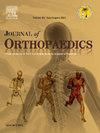Osteotomy across arcuate line in ilium needs prudence in curved periacetabular osteotomy
IF 1.5
Q3 ORTHOPEDICS
引用次数: 0
Abstract
Background
This study aimed to measure the optimal osteotomy angle and length, as well as the available width of the osteotomy site in the posterior column for the safe performance of periacetabular osteotomy.
Methods
Fifty-six hips in 41 patients who underwent curved periacetabular osteotomy were evaluated. Computed tomography data were subjected to multiplanar reconstruction to measure parameters in two reference planes: the functional pelvic plane and the anterior pelvic plane. The optimal osteotomy angle, osteotomy length, and available width of the posterior column were defined. We assessed the possible factors affecting the optimal osteotomy angle.
Results
The functional pelvic plane showed an average and maximum anterior pelvic tilt of 7.8° and 16.4°, respectively, from the anterior pelvic plane. The optimal osteotomy angles had comparable dispersions in the functional pelvic plane and anterior pelvic plane reference planes. Furthermore, as the rotation angle of the reconstructed axial views increased, i.e., the osteotomy site became closer to the arcuate line of the pelvis, the available width of the osteotomy site narrowed, and the length of the osteotomy site increased. We found significant correlations between the optimal osteotomy angle and sex, height, weight, body mass index, head lateralization index, and acetabular anteversion in all planes. The multiple regression analysis revealed that acetabular anteversion was significantly correlated with the optimal osteotomy angle in all planes, while height, weight, BMI, center edge angle, acetabular roof obliquity, and head lateralization index were correlated in some planes.
Conclusions
Osteotomies near the arcuate line of the pelvis are considered particularly risky because long-distance osteotomies must be performed within a narrow width. The optimal osteotomy angle is affected by many factors, including acetabular anteversion, which varies from case to case.
经髂骨弓状线截骨需谨慎行髋臼周围弯曲截骨
本研究旨在测量最佳截骨角度和长度,以及后柱截骨位置的可用宽度,以安全进行髋臼周围截骨。方法对41例行髋臼周围弯曲截骨术患者56髋进行评价。计算机断层扫描数据进行多平面重建,测量骨盆功能平面和骨盆前平面两个参考平面的参数。确定最佳截骨角度、截骨长度和后柱可用宽度。我们评估了影响最佳截骨角度的可能因素。结果功能盆腔平面与骨盆前平面的平均和最大倾斜度分别为7.8°和16.4°。最佳截骨角度在盆腔功能平面和盆腔前平面参考平面上具有相当的弥散度。此外,随着重建轴位旋转角度的增加,即截骨点越来越靠近骨盆弓线,截骨点的可用宽度变窄,截骨点的长度增加。我们发现最佳截骨角度与性别、身高、体重、体重指数、头部偏侧指数和髋臼前倾在所有平面上均有显著相关性。多元回归分析显示,髋臼前倾与最佳截骨角度在所有平面上均显著相关,而身高、体重、BMI、中心边缘角度、髋臼顶倾角、头部偏侧指数在部分平面上存在相关性。结论骨盆弓形线附近的截骨术风险特别大,因为远距离截骨术必须在狭窄的宽度内进行。最佳截骨角度受多种因素影响,包括髋臼前倾,具体情况因人而异。
本文章由计算机程序翻译,如有差异,请以英文原文为准。
求助全文
约1分钟内获得全文
求助全文
来源期刊

Journal of orthopaedics
ORTHOPEDICS-
CiteScore
3.50
自引率
6.70%
发文量
202
审稿时长
56 days
期刊介绍:
Journal of Orthopaedics aims to be a leading journal in orthopaedics and contribute towards the improvement of quality of orthopedic health care. The journal publishes original research work and review articles related to different aspects of orthopaedics including Arthroplasty, Arthroscopy, Sports Medicine, Trauma, Spine and Spinal deformities, Pediatric orthopaedics, limb reconstruction procedures, hand surgery, and orthopaedic oncology. It also publishes articles on continuing education, health-related information, case reports and letters to the editor. It is requested to note that the journal has an international readership and all submissions should be aimed at specifying something about the setting in which the work was conducted. Authors must also provide any specific reasons for the research and also provide an elaborate description of the results.
 求助内容:
求助内容: 应助结果提醒方式:
应助结果提醒方式:


